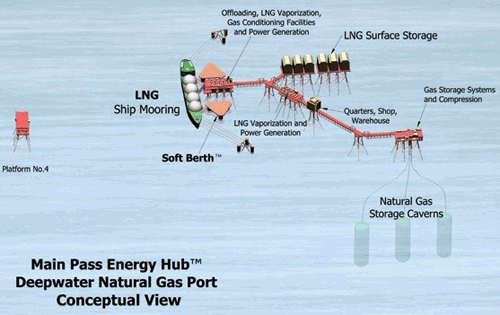
The Main Pass Energy Hub (MPEH) project is a large-scale LNG storage and regasification facility, which will be positioned off the Louisiana coast in the Southern United States.
New Orleans-based McMoRan Exploration Co received Federal approval in January 2007 to build the liquefied natural gas terminal 16 miles east of the Mississippi River capable of processing 10% of the nation’s daily demand of 31 billion cubic feet. The MPEH terminal will be capable of regasifying LNG at a rate of 1.6 billion cubic feet (bcf) of natural gas a day.
In July 2006 McMoRan received final licensing from the US Coast Guard and the Maritime Administration (MARAD) to run a deepwater port and also received approval from the Federal Energy Regulatory Commission to bring gas onshore using its proposed 36in pipeline into Coden, Alabama.
The total investment for the plant will amount to $1bn, which includes the pipeline ($500m) and the LNG terminal ($500m). Baker Botts LLP is the financial advisor to the project.
Freeport-McMoRan Energy LLC (Freeport-McMoRan) was issued a certificate by the Federal Energy Regulatory Commission (FERC) to construct and operate natural gas pipelines near Coden as a part of the Main Pass Energy Hub project. As per 2006 orders, these pipelines should have entered into service within three years. Freeport-McMoRan has filed letters with FERC on 5 May and 18 May 2009, requesting the extension of the construction period. As a result, the period for constructing the Coden pipeline facilities was extended until 18 May 2010.
The extension was sought due to higher LNG prices in the Middle East diverting LNG from the US, reduced industrial demand for natural gas and lower natual gas drilling activities in the US
Logistics
When the MPEH is complete in 2010, the facility will cool natural gas to a fraction of its normal size to allow for transfer of bigger loads at cheaper prices as much as 7¢ to 20¢ per 1,000 cubic feet. While five other such facilities exist, including one off the Texas coastline in the Gulf and another in Lake Charles, the MPEH will be the closest to Louisiana’s shoreline, yet far enough out to service multiple deepwater vessels.
The project is being overseen by Freeport-McMoRan Energy LLC and the Louisiana Department of Economic Development. Total gas handling per year will be 7mtpa of LNG corresponding to 350bcf a year. McMoRan is continuing discussions with potential LNG suppliers as well as gas marketers and consumers in the US to develop commercial arrangements for the facilities.
Prior to commencing construction of the facility, McMoRan expects to enter into commercial arrangements that would enable them to finance the construction costs of the project on favourable terms.
The project is still forced to depend on various market conditions, such as low gas prices, reducing the abilty of the LNG hubs to secure shipments and contracts. The company is in discussions with various suppliers. To be operational, McMoRan is exploring alternative opportunities such as making the project a multi-commodity offshore storage facility.
LNG plant project description
McMoRan has completed conceptual and preliminary engineering for the development of the MPEH. The project will make use of the former sulphur mining structures located 37 miles east of Venice, Louisiana, in 210ft of water at Main Pass Block 299.
The LNG plant will be a 330ft-tall steel hydraulic platform constructed from a modified one-mile-long hub of abandoned sulphur mining platforms (abandoned in the 1980s when the sulphur market crashed). In addition to the receiving and regasification facility an onsite cavern storage facility for natural gas in the two-mile-diameter salt dome structure at this site is being developed with pipeline connections to deliver gas from the MPEH to markets in the US.
Designs include 28bcf of initial cavern storage availability and will allow deliveries from storage of up to 1.5bcf a day (total instant delivery at peak time will therefore be 3.1bcf including 1.6bcf from regasification and 1.5bcf from cavern storage).
There have been environmental concerns over the use of open loop (Open Rack Vaporisation technology (ORV)) (using water from the Gulf, which might in turn kill fish and marine life) to regasify the LNG but these concerns have been allayed as the company has decided to invest a further $30m in a more environmentally considerate closed-loop system.
The state of Louisiana required the use of a ‘closed-loop’ regasification system using Submerged Combustion Vaporisation with Selective Catalytic Reduction (SCV/SCR), which uses natural gas rather than seawater to warm the LNG.
Advantages
The natural gas terminal at Main Pass has numerous potential advantages over other LNG sites including:
- Existing facilities that provide timing, construction and operating cost advantages over undeveloped locations
- Close proximity to offshore shipping channels
- Access to an existing pipeline system and potential to develop other pipeline interconnections that would facilitate the receipt and distribution of natural gas to US gas markets
- Possible security and safety advantages because of its offshore location in relatively deep water
- The potential ability to handle a fleet of new LNG supertankers, which may have limited access to existing US ports



